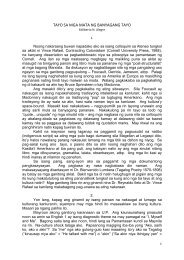ang salot ng plagiarism - fil40 online
ang salot ng plagiarism - fil40 online
ang salot ng plagiarism - fil40 online
Create successful ePaper yourself
Turn your PDF publications into a flip-book with our unique Google optimized e-Paper software.
Dissenti<strong>ng</strong> Opinion of Justice Sereno on the issue of <strong>plagiarism</strong> in the Philippine Supreme Court.<br />
A.M. No. 10-7-17-SC – IN THE MATTER OF THE CHARGES OF PLAGIARISM, ETC.,<br />
AGAINST ASSOCIATE JUSTICE MARIANO C. DEL CASTILLO<br />
Promulgated: October 15, 2010 8<br />
Sa kany<stro<strong>ng</strong>>a<strong>ng</strong></stro<strong>ng</strong>> kontra-opinyon (dissenti<strong>ng</strong> opinion) pinaliwanag ni Associate Justice<br />
Lourdes Sereno <stro<strong>ng</strong>>a<strong>ng</strong></stro<strong>ng</strong>> kany<stro<strong>ng</strong>>a<strong>ng</strong></stro<strong>ng</strong>> oposisyon sa desisyon <strong>ng</strong> mayorya <strong>ng</strong> mga mahistrado <strong>ng</strong><br />
Korte Suprema na nagpawal<stro<strong>ng</strong>>a<strong>ng</strong></stro<strong>ng</strong>> sala kay Associate Justice Mariano C. Del Castillo sa sala <strong>ng</strong><br />
<strong>plagiarism</strong>:<br />
What is black can be called “white” but it cannot turn white by the mere calli<strong>ng</strong>. The unfortunate<br />
ruli<strong>ng</strong> of the majority Decision that no <strong>plagiarism</strong> was committed stems from its failure to disti<strong>ng</strong>uish<br />
between the determination of the objective, factual existence of <strong>plagiarism</strong> in the Vinuya decision[1]<br />
Isabelita C. Vinuya, et al. v. The Honorable Executive Secretary, et al., G.R. No. 1622309, April 28,<br />
2010. [2] and the determination of the liability that results from a findi<strong>ng</strong> of <strong>plagiarism</strong>. Specifically,<br />
it made “malicious intent”, which heretofore had not been relevant to a findi<strong>ng</strong> of <strong>plagiarism</strong>, an<br />
essential element. The majority Decision will thus stand against the overwhelmi<strong>ng</strong> conventions on<br />
what constitutes <strong>plagiarism</strong>. In doi<strong>ng</strong> so, the Decision has created unimaginable problems for<br />
Philippine academia, which will from now on have to find a disciplinary response to <strong>plagiarism</strong><br />
committed by students and researchers on the justification of the majority Decision. It has also<br />
undermined the protection of copyrighted work by maki<strong>ng</strong> available to plagiarists “lack of malicious<br />
intent” as a defense to a charge of violation of copy or economic rights of the copyright owner<br />
committed through lack of attribution.<br />
Sa paglipat <strong>ng</strong> bint<stro<strong>ng</strong>>a<strong>ng</strong></stro<strong>ng</strong>> sa is<stro<strong>ng</strong>>a<strong>ng</strong></stro<strong>ng</strong>> software para sa kakul<stro<strong>ng</strong>>a<strong>ng</strong></stro<strong>ng</strong>>an <strong>ng</strong> mga panipi, sinabi niya:<br />
... no software exists that will automatically type in quotation marks at the beginni<strong>ng</strong> and end of a<br />
passage that was lifted verbatim; these attribution marks must be made with deliberate effort by the<br />
human researcher. Nor can a software program generate the necessary citations without input from<br />
the human researcher. Neither is there a built-in software alarm that sounds every time attribution<br />
marks or citations are deleted. The best guarantee for works of high intellectual integrity is consistent,<br />
ethical practice in the writi<strong>ng</strong> habits of court researchers and judges.<br />
Pagkatapos, sistematiko niy<stro<strong>ng</strong>>a<strong>ng</strong></stro<strong>ng</strong>> tini<strong>ng</strong>nan <stro<strong>ng</strong>>a<strong>ng</strong></stro<strong>ng</strong>> mga diumano’y mga kinopya bahagi <strong>ng</strong><br />
desisyon at ikinumpara sa mga orihinal na akda. A<strong>ng</strong> lumitaw ay hindi lam<stro<strong>ng</strong>>a<strong>ng</strong></stro<strong>ng</strong>> salita-porsalita<br />
na p<stro<strong>ng</strong>>a<strong>ng</strong></stro<strong>ng</strong>>o<strong>ng</strong>opya, kundi <stro<strong>ng</strong>>a<strong>ng</strong></stro<strong>ng</strong>> pinakamalal<stro<strong>ng</strong>>a<strong>ng</strong></stro<strong>ng</strong>> uri <strong>ng</strong> <strong>plagiarism</strong> – <stro<strong>ng</strong>>a<strong>ng</strong></stro<strong>ng</strong>> patse-patse o<br />
tagni-tagni<strong>ng</strong> p<stro<strong>ng</strong>>a<strong>ng</strong></stro<strong>ng</strong>>o<strong>ng</strong>opya – na maari lam<stro<strong>ng</strong>>a<strong>ng</strong></stro<strong>ng</strong>> magawa <strong>ng</strong> is<stro<strong>ng</strong>>a<strong>ng</strong></stro<strong>ng</strong>> malay at bukas-mat<stro<strong>ng</strong>>a<strong>ng</strong></stro<strong>ng</strong>><br />
resertser na may seryoso<strong>ng</strong> intensyon na manlinl<stro<strong>ng</strong>>a<strong>ng</strong></stro<strong>ng</strong>>. Lalo<strong>ng</strong> magigi<strong>ng</strong> maliwanag ito ku<strong>ng</strong>,<br />
gamit <stro<strong>ng</strong>>a<strong>ng</strong></stro<strong>ng</strong>> gabay <stro<strong>ng</strong>>a<strong>ng</strong></stro<strong>ng</strong>> Dissenti<strong>ng</strong> Opinion ni Associate Justice Sereno, gagawan <strong>ng</strong> color-code<br />
<stro<strong>ng</strong>>a<strong>ng</strong></stro<strong>ng</strong>> mga linya na in<stro<strong>ng</strong>>a<strong>ng</strong></stro<strong>ng</strong>>kin <strong>ng</strong> resertser mula sa mga orihinal na akda para makita ku<strong>ng</strong><br />
paano tinahi <stro<strong>ng</strong>>a<strong>ng</strong></stro<strong>ng</strong>> mga ito. Totoo<strong>ng</strong> wal<stro<strong>ng</strong>>a<strong>ng</strong></stro<strong>ng</strong>> software na makakagawa <strong>ng</strong> pagpatse-patse nito.<br />
Na matatagpuan <stro<strong>ng</strong>>a<strong>ng</strong></stro<strong>ng</strong>> uri <strong>ng</strong> <strong>plagiarism</strong> na ito sa mga tala-baba (footnote) <stro<strong>ng</strong>>a<strong>ng</strong></stro<strong>ng</strong>> nagdidiin <strong>ng</strong><br />
panlilinl<stro<strong>ng</strong>>a<strong>ng</strong></stro<strong>ng</strong>>.<br />
Halimbawa <stro<strong>ng</strong>>a<strong>ng</strong></stro<strong>ng</strong>> sumusunod:<br />
Evan J. Criddle & Evan Fox-Decent, “A<br />
Fiduciary Theory of Jus Cogens,” Yale<br />
Journal of International Law (2009)<br />
Peremptory norms began to attract greater<br />
scholarly attention with the publication of Alfred<br />
von Verdross’s influential 1937 article, Forbidden<br />
Treaties in International Law.[FN10]<br />
[FN10] For example, in the 1934 Oscar Chinn<br />
Case, Judge Schücki<strong>ng</strong>’s influential dissent stated<br />
that neither an international court nor an arbitral<br />
tribunal should apply a treaty provision in<br />
Supreme Court’s 28 April 2010 Decision in<br />
Vinuya, et al. v. Executive Secretary, G.R.<br />
No. 162230<br />
xxx but peremptory norms began to attract<br />
greater scholarly attention with the publication<br />
of Alfred von Verdross’s influential 1937 article,<br />
Forbidden Treaties in International Law. [FN72]<br />
[FN 71] (p. 31, Body of the 28 April 2010<br />
Decision)<br />
[71] Classical publicists such as Hugo Grotius,<br />
8 Ti<strong>ng</strong>nan: http://harryroque.com/2010/10/19/dissenti<strong>ng</strong>-opinion-of-justice-sereno-on-the-issue-of-<br />
<strong>plagiarism</strong>-in-the-philippine-supreme-court/<br />
TGMaceda/Plagiarism/ Page 8 of 10



